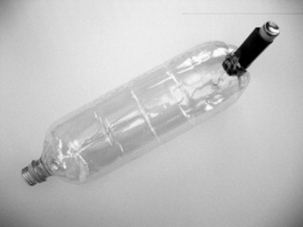Chapter 4 Shortness of breath
Introduction
Shortness of breath is the chief complaint in approximately 8% of 999 calls to the ambulance service, and is the third most common type of emergency call. It can also be an important symptom in patients with a wide range of conditions. Reference should therefore be made to other relevant chapters – particularly that discussing chest pain (Chapter 3). The conditions covered in this chapter include asthma, chronic obstructive pulmonary disease, acute pulmonary oedema and chest infections. The objectives are listed in Box 4.1.
Box 4.1 Chapter objectives
 To describe the recognition of primary survey positive patients and treatment of immediately life threatening problems
To describe the recognition of primary survey positive patients and treatment of immediately life threatening problems To describe the recognition and treatment of primary survey negative patients requiring immediate hospital admission
To describe the recognition and treatment of primary survey negative patients requiring immediate hospital admissionThe common causes of shortness of breath are asthma, chronic obstructive pulmonary disease and pulmonary oedema but there are many other conditions that can pose diagnostic problems (Box 4.2).
Primary survey positive patients
Recognition
Patients with a life threatening respiratory emergency will present in either respiratory failure or respiratory distress. Patients with respiratory distress are still able to compensate for the effects of their illness, and urgent treatment may prevent their further deterioration. They present with signs and symptoms indicating increased work of breathing but findings suggesting systemic effects of hypoxia or hypercapnia will be limited or absent. Conversely, patients with respiratory failure may have limited evidence of increased work of breathing as they become too exhausted to compensate. The systemic effects of hypoxia and hypercapnia will be particularly evident in this group and immediate treatment will be required to prevent cardiac arrest. The key findings of primary survey positive patients with shortness of breath are presented in Box 4.3.
Box 4.3 Recognition of the primary survey positive patient with shortness of breath
Treatment
If it is not possible to obtain an airway, if the patient’s condition is deteriorating rapidly, or they show signs of significant respiratory failure (in particular failure to maintain SpO2 of 95% on high concentration oxygen) consider immediate transportation to a hospital with appropriate facilities. Important treatment points for primary survey positive patients are listed in Box 4.4.
Box 4.4 Treatment for primary survey positive patients
Treatment before transportation
Primary survey negative patients with need for hospital attendance
Primary survey negative patients with the findings listed in Box 4.5 who do not respond to pre-hospital treatment will require hospital admission.
Box 4.5 Diagnostic criteria for primary survey negative patients requiring hospital admission
Findings (not reversed by initial treatment) suggesting need for hospital admission:
 Supplemental oxygen required to maintain SpO2 at 95% or above (or at ‘usual’ level of SpO2 for COPD patients)
Supplemental oxygen required to maintain SpO2 at 95% or above (or at ‘usual’ level of SpO2 for COPD patients)Secondary survey
The SOAPC system should be used to undertake a secondary survey (see Chapter 2). In primary survey positive patients, a secondary survey may not be completed in the pre-hospital phase of treatment as the focus must be on treatment of life threatening problems. For primary survey negative patients requiring hospital care the secondary survey may be undertaken during transportation. For the remaining patient population a secondary survey may be undertaken at the point of contact and will contribute to the decision to admit, treat and refer, or treat and leave.
Subjective assessment
Confirm that the chief complaint is shortness of breath. Remember that this may be a symptom of conditions affecting systems other than the chest (for example, hypovolaemia due to bleeding). Determine if this is a new problem or an exacerbation of a chronic condition. Ask what precipitated the problem and what, if anything, makes the patient feel more or less breathless. Ask about associated symptoms, such as chest pain, cough and sputum production, palpitations, fever and malaise, and leg pain or swelling. Has the patient been using inhalers or nebulisers more than normal? Have they recently sought other medical assistance?
Objective examination
Vital signs
The vital signs that should be recorded in a patient with shortness of breath are listed in Box 4.6.
Social context
In addition to the clinical assessment, it is important to consider the patient’s ability to care for themselves or whether suitable support mechanisms are available. If these are absent, can they be arranged? Can the patient perform the normal activities of daily living – feeding, washing and using the toilet – either with or without support? The time of day and day of the week may also influence the decision about whether to admit or refer the patient, as this may dictate how quickly a patient could be seen by their own GP or reviewed by the emergency care practitioner.
General examination
Look for signs of the ‘unwell’ patient (see Chapter 2). A detailed examination of the respiratory system is mandatory for patients with shortness of breath. Remember, however, that myocardial infarction, acute coronary syndromes and congestive cardiac failure can also result in respiratory distress, as may endocrine and neurological problems (for example Kussmaul’s and Cheyne–Stokes respiration in hyperglycaemia and raised intra-cranial pressure respectively). If a respiratory problem cannot be readily identified as the cause of the patient’s symptoms, undertake an examination of the other systems.
Elderly patients are likely to have multiple pathologies, so undertake a general systems examination
For details of the respiratory examination, refer to Boxes 4.3, 4.5, 4.6 and 4.7 and to Chapter 2. Note if the patient has excessive production of sputum. What colour is this? Yellow, green or brown sputum indicates a chest infection. White frothy sputum, which may also be tinged with pink, suggests pulmonary oedema.
Stay updated, free articles. Join our Telegram channel

Full access? Get Clinical Tree




















































